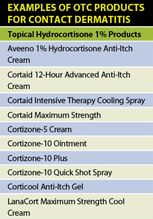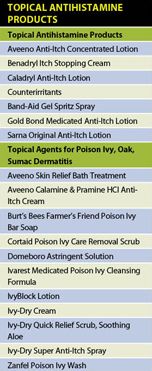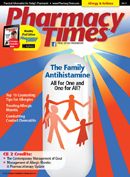Publication
Article
Pharmacy Times
Combating Contact Dermatitis
Author(s):
Topical OTC products can ease skin inflammation caused by exposure to allergens or irritants.
Topical OTC products can ease skin inflammation caused by exposure to allergens or irritants.
Contact dermatitis is a dermatologic condition that is defined as acute inflammation of the skin as a result of an exposure to irritants or allergens. 1 The symptoms and their severity vary from patient to patient and are dependent upon the cause and extent of exposure to the allergen or irritant. Upon exposure to an irritant or allergen, the skin may become inflamed and swollen. Patients with contact dermatitis may also present with symptoms such as pruritus, erytherma, and the formation of vesicles and pustules. 2
Types of Contact Dermatitis
Contact dermatitis may be classified as irritant contact dermatitis (ICD) or allergic contact dermatitis (ACD). 1-3 ICD is the more prevalent form of contact dermatitis, accounting for an estimated 80% to 90% of all cases. It is an inflammatory reaction of the skin that typically resembles a burn and is due to exposure to irritants such as chemicals, soaps, detergents, or various household cleaning products. 1-3 Contact dermatitis is commonly related to one’s occupation and can develop from frequent and repeated use of hand hygiene products, exposure to chemicals, and glove use. 3
The majority of ICD cases occur on exposed or unprotected areas of the skin such as the face, hands, and arms. 2 An estimated 80% of ICD cases occur on the hands and another 10% involve areas of the face. 2 The most common symptoms include inflammation, edema, erythema, and crusting, and the formation of pustules or vesicles. 1,2

ACD is not as prevalent as ICD, and is characterized as an inflammatory reaction of the skin due to an exposure to an allergen, such as poison ivy, poison oak, or poison sumac. 1,2,4 Metal allergy, especially to nickel salts found in jewelry, clothing, and cell phones, is also a common cause of ACD. 2 In addition, the use of cosmetics, fragrances, and some skin care products can cause ACD. 2 The signs and symptoms of ACD may include localized pruritus, rash, pain, and the formation of blisters. 2 The skin may appear red and swollen. 2 Differentiating ACD from ICD may be difficult, especially if the cause of the irritation is unknown; however, ACD is typically confined to the contact area, whereas ICD may appear more widespread on the skin. 5 In general, a red rash typically occurs immediately in cases of ICD, whereas sometimes in ACD a rash may not appear for 24 to 48 hours after exposure to an allergen. 5
OTC Products for Contact Dermatitis
Many patients with contact dermatitis will elect to use OTC topical products to provide symptomatic relief. Products marketed for contact dermatitis may contain a combination of ingredients in various dosage forms, including creams, ointments, gels, lotions, and sprays.
Topical hydrocortisone (Table 1), oral antihistamines, and other antipruritic agents are often employed to manage dermatitis. Patients can also use astringent products (eg, aluminum acetate, zinc oxide, zinc acetate) to promote drying of moist, wet, oozing lesions and to serve as a protective covering for inflamed skin. 2 Calamine and colloidal oatmeal baths are also helpful in providing relief from itching. 2

Hydrocortisone is considered the most effective topical therapy for treating the symptoms of mild to moderate cases of ICD and ACD that do not involve edema and extensive areas of the skin. 2 As a nonprescription product, it is available in 0.5% or 1% strength (Table 2). Topical hydrocortisone should not be used in children younger than 2 years and should not be used for more than 7 days unless directed by a physician. 2
Patients electing to use topical antihistamine products should be reminded that these agents can cause sensitivity reactions. They should not be used concurrently with other antihistamine-containing products, including oral dosage forms, because increased serum concentrations may occur. 2 Topical antihistamines should not be applied to large areas of the skin. 2 It is also important to remind patients that topical antihistamines should not be applied to broken, blistered, or oozing skin, and should not be used for more than 7 days unless otherwise directed. 2 In addition, external analgesics, such as phenol, menthol, and camphor, may provide antipruritic and anesthetic relief. 2 These products should not be used on open lesions and inflamed skin because they may cause local irritation and burning.2
Prior to recommending any product for contact dermatitis, it is imperative for pharmacists to ascertain the appropriateness of self-treatment and refer patients to seek further medical evaluation when warranted, especially if signs of skin infection are present. Patients younger than 2 years should always be referred to their primary health care provider for appropriate treatment. Once exposed to an irritant or allergen, patients should wash the affected area gently to remove the irritant.2 Patients with allergies to skin care products and cosmetics should be advised to use hypoallergenic products to avoid allergic reactions.
During counseling, patients should be instructed on the proper use and duration of the selected product, as well as possible adverse effects. Pharmacists can also recommend the use of colloidal oatmeal bath products to soothe affected areas and remind patients to immediately contact their primary health care provider if symptoms worsen or show no signs of improvement after self-treatment. As a result of the patient’s immune system, both ICD and ACD will typically resolve in 10 to 21 days with or without medical treatment.2 PT
Ms. Terrie is a clinical pharmacy writer based in Haymarket, Virginia.
References
1. Dermatological disorders. In: Beers MH, Porter RS, Jones TV, Kaplan JL, Berkwits M, eds. The Merck Manual of Diagnosis and Therapy. 18th ed. Rahway, NJ: Merck & Co, Inc; Section 10:956-958.
2. Contact dermatitis and latex allergy. Centers for Disease Control Web site. www.cdc.gov/oralhealth/infectioncontrol/faq/latex.htm. Accessed March 12, 2011.
3. Plake K, Darbishire P. Contact dermatitis. In: Berardi R, Newton G, McDermott JH, et al, eds. Handbook of Nonprescription Drugs. 16th ed. Washington, DC: American Pharmacists Association; 2009:657-672.
4. Contact dermatitis. Medline Plus Web site. www.nlm.nih.gov/medlineplus/ency/article/000869.htm. Accessed March 12, 2011.
5. Contact dermatitis. MedicineNet Web site. www.emedicinehealth.com/contact_dermatitis/page3_em.htm. Accessed March 12, 2011.







